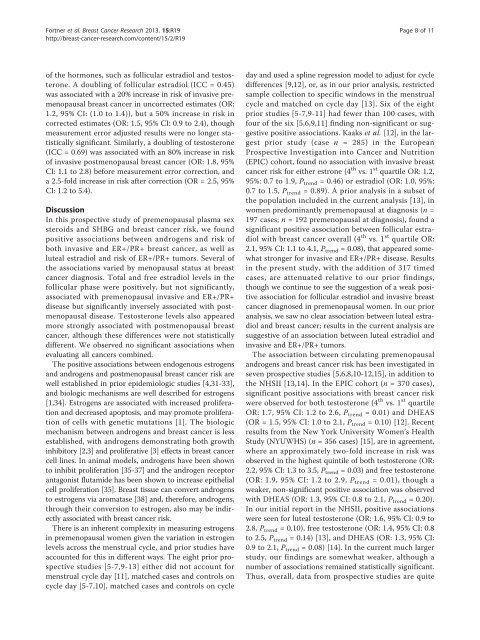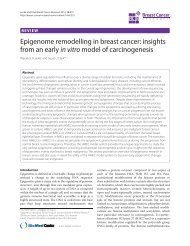results from the Nurses' Health Study II - Breast Cancer Research
results from the Nurses' Health Study II - Breast Cancer Research
results from the Nurses' Health Study II - Breast Cancer Research
You also want an ePaper? Increase the reach of your titles
YUMPU automatically turns print PDFs into web optimized ePapers that Google loves.
Fortner et al. <strong>Breast</strong> <strong>Cancer</strong> <strong>Research</strong> 2013, 15:R19<br />
http://breast-cancer-research.com/content/15/2/R19<br />
Page 8 of 11<br />
of <strong>the</strong> hormones, such as follicular estradiol and testosterone.<br />
A doubling of follicular estradiol (ICC = 0.45)<br />
was associated with a 20% increase in risk of invasive premenopausal<br />
breast cancer in uncorrected estimates (OR:<br />
1.2, 95% CI: (1.0 to 1.4)), but a 50% increase in risk in<br />
corrected estimates (OR: 1.5, 95% CI: 0.9 to 2.4), though<br />
measurement error adjusted <strong>results</strong> were no longer statistically<br />
significant. Similarly, a doubling of testosterone<br />
(ICC = 0.69) was associated with an 80% increase in risk<br />
of invasive postmenopausal breast cancer (OR: 1.8, 95%<br />
CI: 1.1 to 2.8) before measurement error correction, and<br />
a 2.5-fold increase in risk after correction (OR = 2.5, 95%<br />
CI: 1.2 to 5.4).<br />
Discussion<br />
In this prospective study of premenopausal plasma sex<br />
steroids and SHBG and breast cancer risk, we found<br />
positive associations between androgens and risk of<br />
both invasive and ER+/PR+ breast cancer, as well as<br />
luteal estradiol and risk of ER+/PR+ tumors. Several of<br />
<strong>the</strong> associations varied by menopausal status at breast<br />
cancer diagnosis. Total and free estradiol levels in <strong>the</strong><br />
follicular phase were positively, but not significantly,<br />
associated with premenopausal invasive and ER+/PR+<br />
disease but significantly inversely associated with postmenopausal<br />
disease. Testosterone levels also appeared<br />
more strongly associated with postmenopausal breast<br />
cancer, although <strong>the</strong>se differences were not statistically<br />
different. We observed no significant associations when<br />
evaluating all cancers combined.<br />
The positive associations between endogenous estrogens<br />
and androgens and postmenopausal breast cancer risk are<br />
well established in prior epidemiologic studies [4,31-33],<br />
and biologic mechanisms are well described for estrogens<br />
[1,34]. Estrogens are associated with increased proliferation<br />
and decreased apoptosis, and may promote proliferation<br />
of cells with genetic mutations [1]. The biologic<br />
mechanism between androgens and breast cancer is less<br />
established, with androgens demonstrating both growth<br />
inhibitory [2,3] and proliferative [3] effects in breast cancer<br />
cell lines. In animal models, androgens have been shown<br />
to inhibit proliferation [35-37] and <strong>the</strong> androgen receptor<br />
antagonist flutamide has been shown to increase epi<strong>the</strong>lial<br />
cell proliferation [35]. <strong>Breast</strong> tissue can convert androgens<br />
to estrogens via aromatase [38] and, <strong>the</strong>refore, androgens,<br />
through <strong>the</strong>ir conversion to estrogen, also may be indirectly<br />
associated with breast cancer risk.<br />
There is an inherent complexity in measuring estrogens<br />
in premenopausal women given <strong>the</strong> variation in estrogen<br />
levels across <strong>the</strong> menstrual cycle, and prior studies have<br />
accounted for this in different ways. The eight prior prospective<br />
studies [5-7,9-13] ei<strong>the</strong>r did not account for<br />
menstrual cycle day [11], matched cases and controls on<br />
cycle day [5-7,10], matched cases and controls on cycle<br />
day and used a spline regression model to adjust for cycle<br />
differences [9,12], or, as in our prior analysis, restricted<br />
sample collection to specific windows in <strong>the</strong> menstrual<br />
cycle and matched on cycle day [13]. Six of <strong>the</strong> eight<br />
prior studies [5-7,9-11] had fewer than 100 cases, with<br />
four of <strong>the</strong> six [5,6,9,11] finding non-significant or suggestive<br />
positive associations. Kaaks et al. [12], in <strong>the</strong> largest<br />
prior study (case n = 285) in <strong>the</strong> European<br />
Prospective Investigation into <strong>Cancer</strong> and Nutrition<br />
(EPIC) cohort, found no association with invasive breast<br />
cancer risk for ei<strong>the</strong>r estrone (4 th vs. 1 st quartile OR: 1.2,<br />
95%: 0.7 to 1.9, P trend = 0.46) or estradiol (OR: 1.0, 95%:<br />
0.7 to 1.5, P trend = 0.89). A prior analysis in a subset of<br />
<strong>the</strong> population included in <strong>the</strong> current analysis [13], in<br />
women predominantly premenopausal at diagnosis (n =<br />
197 cases; n = 192 premenopausal at diagnosis), found a<br />
significant positive association between follicular estradiol<br />
with breast cancer overall (4 th vs. 1 st quartile OR:<br />
2.1, 95% CI: 1.1 to 4.1, P trend = 0.08), that appeared somewhat<br />
stronger for invasive and ER+/PR+ disease. Results<br />
in <strong>the</strong> present study, with <strong>the</strong> addition of 317 timed<br />
cases, are attenuated relative to our prior findings,<br />
though we continue to see <strong>the</strong> suggestion of a weak positive<br />
association for follicular estradiol and invasive breast<br />
cancer diagnosed in premenopausal women. In our prior<br />
analysis, we saw no clear association between luteal estradiol<br />
and breast cancer; <strong>results</strong> in <strong>the</strong> current analysis are<br />
suggestive of an association between luteal estradiol and<br />
invasive and ER+/PR+ tumors.<br />
The association between circulating premenopausal<br />
androgens and breast cancer risk has been investigated in<br />
seven prospective studies [5,6,8,10-12,15], in addition to<br />
<strong>the</strong> NHS<strong>II</strong> [13,14]. In <strong>the</strong> EPIC cohort (n = 370 cases),<br />
significant positive associations with breast cancer risk<br />
were observed for both testosterone (4 th vs. 1 st quartile<br />
OR: 1.7, 95% CI: 1.2 to 2.6, P trend =0.01)andDHEAS<br />
(OR = 1.5, 95% CI: 1.0 to 2.1, P trend = 0.10) [12]. Recent<br />
<strong>results</strong> <strong>from</strong> <strong>the</strong> New York University Women’s <strong>Health</strong><br />
<strong>Study</strong> (NYUWHS) (n = 356 cases) [15], are in agreement,<br />
where an approximately two-fold increase in risk was<br />
observed in <strong>the</strong> highest quintile of both testosterone (OR:<br />
2.2, 95% CI: 1.3 to 3.5, P trend = 0.03) and free testosterone<br />
(OR: 1.9, 95% CI: 1.2 to 2.9, P trend =0.01),thougha<br />
weaker, non-significant positive association was observed<br />
with DHEAS (OR: 1.3, 95% CI: 0.8 to 2.1, P trend = 0.20).<br />
In our initial report in <strong>the</strong> NHS<strong>II</strong>, positive associations<br />
were seen for luteal testosterone (OR: 1.6, 95% CI: 0.9 to<br />
2.8, P trend =0.10),freetestosterone(OR:1.4,95%CI:0.8<br />
to 2.5, P trend = 0.14) [13], and DHEAS (OR: 1.3, 95% CI:<br />
0.9 to 2.1, P trend = 0.08) [14]. In <strong>the</strong> current much larger<br />
study, our findings are somewhat weaker, although a<br />
number of associations remained statistically significant.<br />
Thus, overall, data <strong>from</strong> prospective studies are quite






